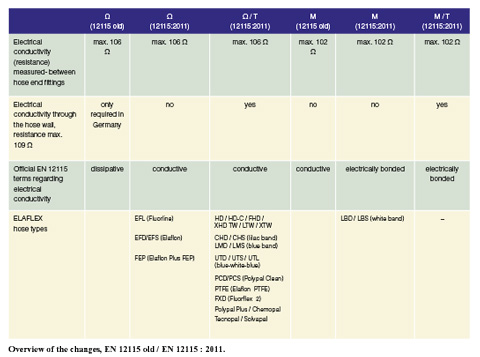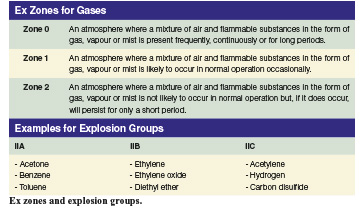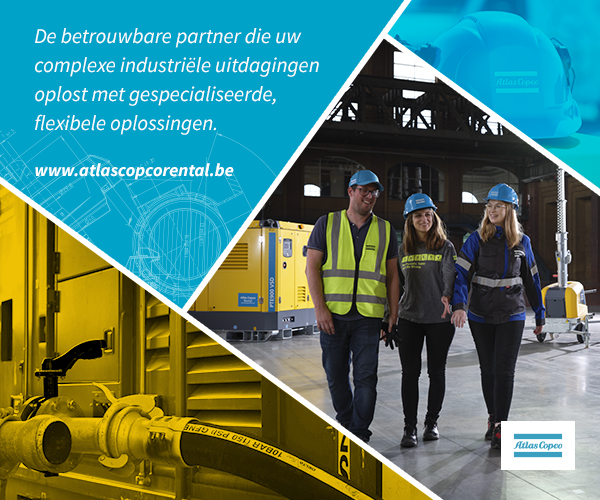For each member country, EN standards are adopted into a national version. Since 1999, the German EN 12115 version has required that «OHM» hoses would need electrical conductivity through the hose wall (max. electrical resistance 109 Ω). This now has been universally adopted in the standard.
Wherever the EN 12115 is valid, the new safety requirements are applicable: Ω (and M) hoses used in explosive environments must have an electrical resistance through the tube wall of maximum 109 Ω.
To indicate this property, these hoses are identified as Ω/T respectively M/T hoses. Hose assemblies with an electrical resistance through the hose wall of greater than 109 Ω are marked with M or Ω respectively.
Use in explosive environment
Hose assemblies can build up electrostatic energy, due to the medium passing through them, or due to e.g. pulling over the ground. If not dissipated, the charge can reach such a high energy level that for example coupling the hose might create a spark that brings an explosive mixture to ignite.

To avoid this dangerous situation, hoses used for liquids whose gases can form explosive mixtures and/or which are used in an explosive environment have to conform to European and international regulations for their safe construction. An important constructional property is the electrical resistance between the hose end fittings.
When safety requirements are highest, EN 12115: 2011 and IEC 60079-32-1: 2011 (basis of EN 12115 regarding electrostatic safety) call for additional safety measures. This is i.e. the case if the hose assembly is used entirely or to a major part within an explosive environment (Ex zone). In this case, an electrical charge on the inner surface of the hose lining must be able to be safely dissipated through the hose wall (IEC 60079-32-1: 2011, 7.7.3.4). The resistance of the hose wall may not ex- ceed 109 Ω.
On the other hand, if a hose assembly is used under normal conditions (e. g. for filling a container where an Ex zone usually is confined to the coupling area only), the hose wall is not required to be electrically conductive (IEC 60079-32-1: 2011,7.7.3.4, Table 17).
Selection guidelines for chemical hoses
Ω/T = For highest safety requirements The complete hose assembly consists of electrically conductive rubber blends. Conductivity 109 Ω through the hose wall. Suitable for explosive mixtures inside, and for the use in hazardous areas (hose entirely or to a major part within an Ex zone). Suitable for media of explosion group higher than IIA (IIB or IIC). Also suitable for critical, non-conductive chemicals like toluene.
Ω = High security due to conductive rubber mixtures
Suitable for normal use, for example as a filling hose for liquids of explosion group IIA. If the hose is only partially used in a hazardous area - e.g., the Ex zone is confined to the coupling area which is mostly the case - the use of an Ω hose is admissable.
M/T = Principally this type can be used as Ω/T hoses
However, contrary to Ω and Ω/T hose assemblies it must be considered that the electrical conductivity of M/T (and M) hoses is created by metallic conductors. The electrical connection within the tube is subject to high loads. In the worst case it can be broken. Regular monitoring of the conductivity is recommended. Further, the use of M/T (and M) hose assemblies should be avoided when so-called stray currents can be expected in the environment of the hose.
M = Suitable for normal use, for example as a filling hose for liquids of explosion group IIA, but this type is subject to the same restrictions as M/T hoses.

«Less conductive» is safer
From the current standards regarding Ex requirements, e.g. EN12115 and IEC, it can be seen that in comparison to M type hoses, Ω/T and Ω hoses offer higher safety when used in their particular application range, because there are no restrictions to be taken into account, as it is the case with M hose assemblies.
When talking about electrical resistance, it is important to understand that high conductivity (very low electrical resistance) does not mean that a hose is safer to use. Due to the fact that the electrical connectors are bonded to the couplings, M type hose assemblies have an electrical resistance (measured between hose ends) of max. 100 Ohm.
On the other hand, Ω hose assemblies show a higher electrical resistance, up to max. 1 Million Ohm. Possible external currents, such as stray currents from distant electrical systems (e. g. E-locomotives, generators) can be safely dissipated. In contrast, with M hoses, because of the very low resistance, there is a risk that very large currents flow through the hose, potentially leading to sparks which can ignite explosive mixtures.
«Ω/T conductivity»: further explanations
For some applications, Ω and M hoses with non-conductive lining (surface in contact with the medium) but conductive reinforcements and hose cover may bear the risk that the lining is damaged by electrostatic discharge.
This can be the case with some critical, electrically non-conductive media like Toluene or Heptane. Electrical charge can build up on the surface of the hose lining. If the lining is non-conductive, this energy can not be passed on to the couplings and if it reaches a high level, it might break through the hose lining. This can damage (puncture) the hose.
By choosing a hose assembly with an electrical resistance of max 109 Ω through the hose wall (Ω/T conductivity), this can be avoided.
(photos: Elaflex) (by Achim Aehle, Karsten Ehlers, Elaflex)













